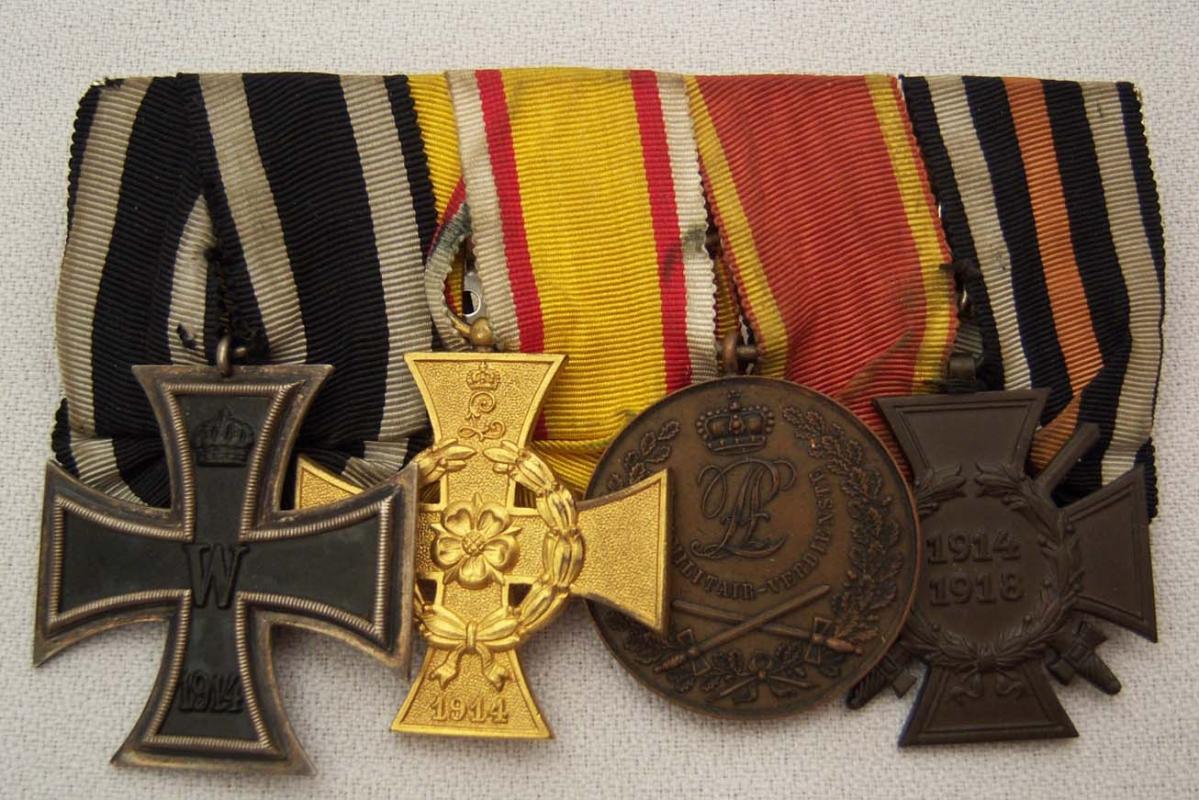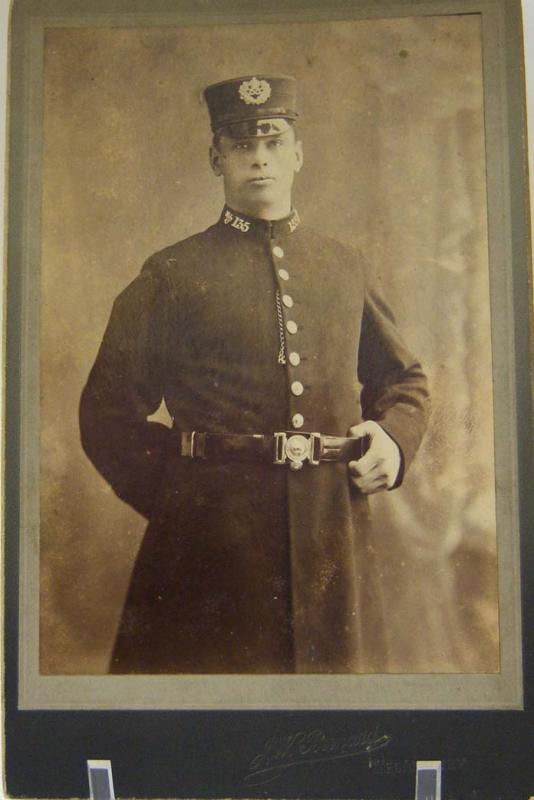-
Posts
6,486 -
Joined
-
Last visited
-
Days Won
10
Content Type
Profiles
Forums
Blogs
Gallery
Events
Store
Posts posted by Brian Wolfe
-
-
Hello Rod.
I saw your post on the New Content list and started with post #1 and enjoyed a nostalgic review of your room from years back.
An enjoyable tour with my morning coffee.
I see that Mervyn has read my mind once again so I'll simply echo his statment in welcoming you back and looking forward to seeing more of your collection
Regards
Brian
0 -
Hi Mike,
I would say you secured a great piece of history, whether military or not.
Very nice artifact, well done and you didn't make commit the collector's sin of keeping money in your pocket:
God bless you my son.

Regards
Brian
0 -
Too often these financial driven moves prove to be both ineffective and inefficient.
it has happened here as well throughout Ontario and now many are regretting such decisions.
Sorry to hear about the loss of your constabulary, Robin.
Regards
Brian
0 -
A simple question yet not so simple to pick just one.
Here's one from my collection I like, not the biggest or the most colourful, I just like it.
Regards
Brian
 0
0 -
Hello David,
Allow me to echo Mervyn's welcome to the forum.
You have obviously put in a lot of time and thought into your post and because it is an important subject I have "pinned" the topic in this section.
This will allow as many members to read your post and perhaps make their comments and suggestions.
Again, welcome to the forum and thank you for your post.
Regards
Brian
0 -
Proof positive that there is more to life (collecting life) than guns and medals that are worth while.
Very nice, and I would think rare, find Mike; well done.
Regards
Brian
0 -
Hi Tony,
Interesting specimen shown in the link.
I have never run onto the MANGROVITE spamping on the scabbard before, though I was aware they were maked this way.
Of course here in Canada we saw mostly Canadian and British examples for sale. Back in the 1960's there were going for .99 cents each and you had the pick of the "crop".
Regards
Brian
0 -
That's the in depth information we like to see in our posts.
Many thanks Douglas.
Regards
Brian
0 -
Here a little more information which may be verified in the book "Australian Service Bayonets" by Ian D. Skennerton.
The earlier specimens had no cleaning hole in the pommel while all the ones made later had them.
MA is a mark indicating that it was manufactured in Australia.
The markings on the ricasso look to be "9 42" which would indicate a manifacturing date of September (the number 9) 1942, or are my old eyes failing me? There is mention of 1912, which is why I am asking this question regarding the manufacturing date.
These were used throughout WWII by the Australian troops with the S.M.L.E. rifle.
Regards
Brian
0 -
-
I am always astounded at the information that comes back about Japanese swords. Let me explain. The leather covering is a field cover which simply means it was used to protect the scabbard when the officer was in the field. Whether he was a officer of a landing force or a post clerk is not known by the leather covering on a scabbard. The postal clerk remark was simply an example just so no one from another forum comes back with a long and drawn out reason why this could not have been a postal clerk. I know that. Sorry if I sound a bit "short" it is not intential.
I remember the NCO swords being sold that had wooden handles a number of years ago. Everyone said that they were Japanese Marine NCO Landing forces. Which was a load of nonsence as the wooden handle was used instead of the aluminum ones due to lack of aluminum for the purpose later in the war.
It's a lot like back in the day when every Japanese sword was taken off a dead Japanese Major by someone's uncle and brought back with blood still caked onto the blade. If every sword brought back belonged to a Japanese Major then their army must have been filled to the gills with Majors. Not to mention the stench of dried blood. These are basically urabn myths.
The sword you have posted is a great pirce of history and one I would indeed like to hear more about, Landing Forces Officer notwithstanding.

Regards
Brian
0 -
What a great find! Like finding the lost Dutchman gold mine, (I have maps and will negotiate a price).

Regards
Brian
0 -
Yep, Kai gunto alright, the T'suba (hand guard) is a dead give away, it greatly differs from the army version which I think is the Shun gunto.
Good luck on the translation, please do post what you find out when the information arrives.
Regards
Brian
0 -
Hi Irish,
I would have suggested that perhaps you were suffering from blunt force trauma to the brain caused by artillery concussion but you have posted some very good examples to back up your opinions. The decoration on the PPK is spectacular to say the least. This post was bound to generate a lot of differences in opinion due to personal preferences. Not everyone in the world would recognize frearms as some of the best examples of enginerring genius as we would. I find the 1897 "Broom Handle" Mauser to be a rather chunky and awkward firearm, as an example, and feels awkward in the hand and is not very nice to fire. However, the engineering is wonderful and add the wooden holster/shoulder stock and you have a deadly weapon that is very accurate. I miss mine (sold it...I'm an idiot!).
So, no argument from me on your choice I only wish I could afford all of them for the collection.
By the way, so far everyone has posted iconic weapons without question, well done fellows.
Regards
Brian
0 -
This is an Australian bayonet.
XOA = a bend test (X) by the manufacturer at Orange (OA)
SLAZ = Slazenger and is only found on the wooden grips.
The "C" marking is, I believe, only an accountability number (production run numbering) but I stand to be corrected on that.
I have never run onto any indication that the bayonet number corrisponds with a rifle number as in Japanese swords and their scabbards of the WWII period. Again I stand to be corrected as my information is dated and my memory is for from infallible.
Regards
Brian
0 -
When you are right you are right, Douglas.
Was there ever a more beautiful pistol?
.
Regards
Brian
0 -
What can be said? This is a wonderful post and well worth pinning so that is is not shuffled down the list of posts too soon.
Many thanks for taking the time to post this interesting material.
Regards
Brian
0 -
Hello Bernhard,
Thank you for this very interesting and informative historical account.
Regards
Brian
0 -
Hello John,
When it comes to WWII Japanese swords the presentation, or surrender, swords are the top collectable. While there are a good deal of WWII Japanese swords available on the collector's market you don't see many with the engraved presentation plate. Very nice indeed. Thanks for posting them.
Regards
Brian
1 -
I would not jump to conclusions based on any odd badges that come with a group. The tags do show RAF and the medals are not named so they are probably his and British. The trading of badges was common both during and after the war. My wife's uncle was in the Signals corps and the medals he had went to the Royal Canadian Lefion for display with the exception of his cap badges and collar badges which I now have along with a photo of him in uniform. In the box with the badges was a small assortment of other odds and ends of insignia and badges that my wife's aunte said he brought home from the Legion were other members gave them to him. If we were to guess his unit based on the medals and insignia it could have been any 9of a number of corps.
As a general comment; many collectors will add hat badges to a group of medals, in this case in point, WWI medals, to make the collection look more attractive in the drawer or case. This is all well and good as WWI British Commonwealth Medals are all named and include the rank and corps. If you take this one step farther and to a photo of a WWII serviceman you add a group of medals that match the ribbon bar or the medals in the photo, if there are any shown, then add a hat badge etc. you have created something that is not really historically accurate, a nice display but not authentic. I am guilty of this myself, finding a nice photo of a soldier, British, Canadian, Imperial German or Japanese and because I have an exact group in the collection I add the photo to the drawer. I am sure that when I am gone and the collection sold this will be assumed to be the medals of the soldier in the photo. My bad.
To be clear, I am not making any comment on the group originally shown in this post but rather making an observation that perhaps will generate some debate.
Regards
Brian
0 -
This just arrived today, a photo of a Staffordshire PC wearing the uniform introduced in 1860.
Regards
Brian
 0
0 -
If your looking for some older topics in the section regarding Japanese material please check the Japan Section as I have moved them.
If you notice any that I have missed please contact me and I will take care of them.
Many thanks to Nick (JapanX) for finding the ones I have moved and drawing them to my attention.
Regards
Brian
0 -
Please note that, thanks to JapanX, I have moved the topics regarding China to the correct section.
If anyone sees more that need to be moved please contact me and I'll look after it.
Regards
Brian
0 -
Jean-Paul,
Thanks for posting this and lets hope that is the medals are named it will help in their return.
We hear of this sort of crim in that area of the world all too often.
Larry,
So well said.
Regards
Brian
0




WELCOME HOME - THE ABSENT-MINDED BEGGAR
in Great Britain: Empire: Colonial Including South Africa & India: Awards, Militaria & History
Posted
Very nice, Mike.
Thanks for posting this.
Regards
Brian